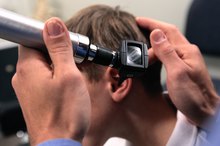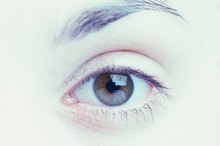Cranial Nerves That Affect the Eye
“LR 6, SO 4, 3” is one of the many expressions that medical students across the country memorize, for it represents three of the cranial nerves and the eye muscles that they affect. There are actually 12 cranial nerves; three of them stimulate the eye muscles, while three others affect the eye in other ways. “LR 6” is the lateral rectus muscle stimulated by cranial nerve 6. “SO 4” is the superior oblique muscle stimulated by cranial nerve 4. The “3” is for cranial nerve 3 which stimulates, innervates, the remaining eye muscles.
Cranial Nerve 2
Cranial nerve 2 is also called the optic nerve. This nerve exits the eye through an area in the back of the eye called the optic disk and goes to the brain stem. Once it is there, some of the nerve fibers that are from the right eye will go to the left side of the brain 2. Likewise, some of the fibers that are from the left eye will go to the right side of the brain 2. It is in this way that both sides of the brain, or what is called the hemispheres, will receive information from both of eyes. There are numerous diseases that can affect the optic nerve, including multiple sclerosis, chickenpox, tuberculosis, syphilis, meningitis, lupus and diabetes, to name just a few. In addition, the nerve fibers cross in an area that is called the optic chiasm, located in front of the pituitary gland. If the fibers are cut before reaching the optic chiasm, you will become blind in that eye. If the fibers are damaged at the chiasm, or after they have passed through it, then you will have a vision loss, but of either half or one quarter of your visual field for that eye.
- Cranial nerve 2 is also called the optic nerve.
- In addition, the nerve fibers cross in an area that is called the optic chiasm, located in front of the pituitary gland.
Cranial Nerve 3
Parts of the Brain That Control Sight
Learn More
Cranial nerve 3 is also called the oculomotor nerve, because this is the main nerve that stimulates ther eye (ocular) muscles. If this nerve has been damaged, by disease or trauma, your pupil will be larger than normal and will not be functioning properly; your eyelid will droop; and the eye itself will be drooping slightly downwards and looking out towards the side of your face.
Cranial Nerve 4
This is the trochlear nerve, which stimulates one of the eye muscles; namely, the superior oblique muscle. If this nerve has been damaged, when you move your eye to look towards your nose, you will not be able to move your eye downwards. Walking downstairs will give you double vision. This nerve can be damaged if you undergo any severe injuries to your head.
- This is the trochlear nerve, which stimulates one of the eye muscles; namely, the superior oblique muscle.
- This nerve can be damaged if you undergo any severe injuries to your head.
Cranial Nerve 5
How Your Eyes Send Images to the Brain
Learn More
The trigeminal nerve is composed of three parts, called branches; the V1, V2 and V3 branches. The V1, or ophthalmic branch, gives feelings of sensation to your eye, as well as to your eyelid and your lacrimal gland, the gland that releases tears 3.
Cranial Nerve 6
This is the abducens nerve, which also stimulates one eye muscle, the lateral rectus muscle 2. If you damage this nerve, you will not be able to move your eye laterally; that is, in the direction away from your nose. You can damage the abducens nerve if the pressure inside your brain increases high enough or from having a brain tumor.
Cranial Nerve 7
This is the facial nerve and it affects your eye only because it is needed to close your eyelid. In other words, if this nerve is damaged, as during a disease called Bell’s palsy, you will not be able to close your eye.
Related Articles
References
- “Essential Clinical Anatomy;” Keith Moore, PhD, Anne Agur; 1995
- University of Michigan Kellogg Eye Center: The Visual Pathway
- “Vaughan & Asbury's General Ophthalmology;” Paul Riordan-Evan, FRCS, John Whitcher, M.D.; 2008
- Schofield PW, Doty RL. The influence of head injury on olfactory and gustatory function. Handb Clin Neurol. 2019;164:409-429. doi:10.1016/B978-0-444-63855-7.00023-X
- El mograbi A, Soudry E. Ocular cranial nerve palsies secondary to sphenoid sinusitis. World J Otorhinolaryngol Head Neck Surg. 2017;3(1):49-53. doi:10.1016/j.wjorl.2017.02.001
- Brown S, Isaacson B, Kutz W, Barnett S, Rozen SM. Facial nerve trauma: clinical evaluation and management strategies. Plast Reconstr Surg. 2019;143(5):1498-1512. doi:10.1097/PRS.0000000000005572
- Nguyen J, Duong H. Anatomy, head and neck, eye nerves. StatPearls. Updated November 13, 2019.
- Park KA, Min JH, Oh SY, Kim BJ. Idiopathic third and sixth cranial nerve neuritis. Jpn J Ophthalmol. 2019;63(4):337-343. doi:10.1007/s10384-019-00666-7
Resources
Writer Bio
Based in North Carolina, Ruth Coleman has written articles and manuals for more than 25 years. Her writing has appeared in community newspapers and places of employment. Coleman holds a Bachelor of Science in biology from Salem College, a Doctor of Medicine from Ross University and is the recipient of numerous academic awards.








